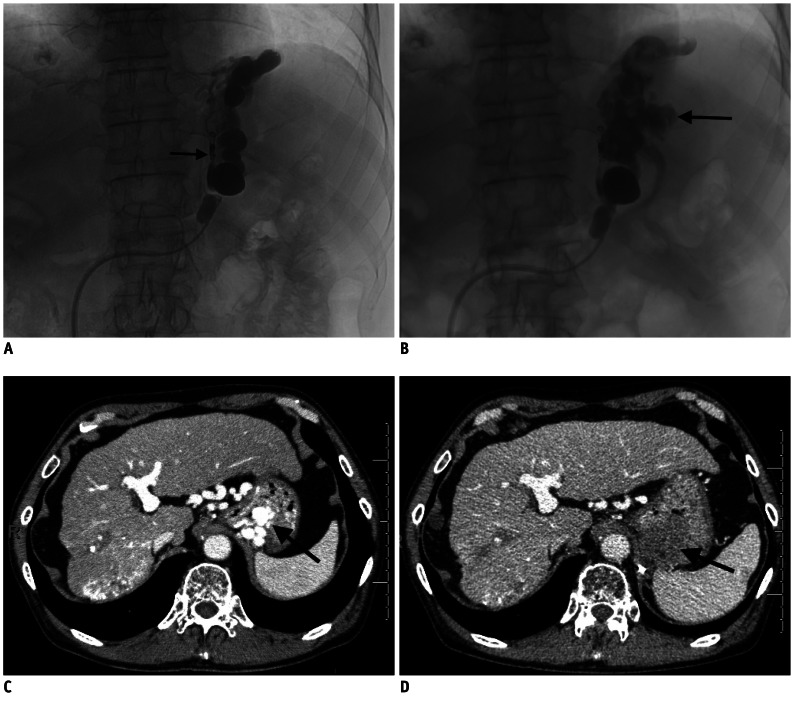1. Sarin SK, Lahoti D, Saxena SP, Murthy NS, Makwana UK. Prevalence, classification and natural history of gastric varices: a long-term follow-up study in 568 portal hypertension patients. Hepatology. 1992; 16:1343–1349. PMID:
1446890.

2. Watanabe K, Kimura K, Matsutani S, Ohto M, Okuda K. Portal hemodynamics in patients with gastric varices. A study in 230 patients with esophageal and/or gastric varices using portal vein catheterization. Gastroenterology. 1988; 95:434–440. PMID:
3391371.
3. Pagliaro L, D'Amico G, Luca A, Pasta L, Politi F, Aragona E, et al. Portal hypertension: diagnosis and treatment. J Hepatol. 1995; 23(Suppl 1):36–44. PMID:
8551010.
4. Trudeau W, Prindiville T. Endoscopic injection sclerosis in bleeding gastric varices. Gastrointest Endosc. 1986; 32:264–268. PMID:
3488937.

5. Fukuda T, Hirota S, Sugimura K. Long-term results of balloon-occluded retrograde transvenous obliteration for the treatment of gastric varices and hepatic encephalopathy. J Vasc Interv Radiol. 2001; 12:327–336. PMID:
11287510.

6. Kanagawa H, Mima S, Kouyama H, Gotoh K, Uchida T, Okuda K. Treatment of gastric fundal varices by balloon-occluded retrograde transvenous obliteration. J Gastroenterol Hepatol. 1996; 11:51–58. PMID:
8672742.

7. Koito K, Namieno T, Nagakawa T, Morita K. Balloon-occluded retrograde transvenous obliteration for gastric varices with gastrorenal or gastrocaval collaterals. AJR Am J Roentgenol. 1996; 167:1317–1320. PMID:
8911204.

8. Hirota S, Matsumoto S, Tomita M, Sako M, Kono M. Retrograde transvenous obliteration of gastric varices. Radiology. 1999; 211:349–356. PMID:
10228513.

9. Yamagami T, Kato T, Hirota T, Yoshimatsu R, Matsumoto T, Nishimura T. Infusion of 50% glucose solution before injection of ethanolamine oleate during balloon-occluded retrograde transvenous obliteration. Australas Radiol. 2007; 51:334–338. PMID:
17635469.

10. Kiyosue H, Tanoue S, Kondo Y, Maruno M, Takaji R, Matsuoto S, et al. Balloon-occluded retrograde transvenous obliteration of complex gastric varices assisted by temporary balloon occlusion of the splenic artery. J Vasc Interv Radiol. 2011; 22:1045–1048. PMID:
21708324.

11. Hirota S. Kuribayashi S, Nakamura K, Hirota S, Yoshioka T, editors. B-RTO (Balloon Occluded Retrograde Transvenous Obliteration). IVR manual. 2011. 2nd ed. Tokyo: Igaku-Shoin;p. 174–179.
12. Somberg KA. TIPS: safe, effective, better? Am J Gastroenterol. 1997; 92:1412–1416. PMID:
9317054.
13. Rodríguez-Laiz JM, Bañares R, Echenagusia A, Casado M, Camuñez F, Pérez-Roldán F, et al. Effects of transjugular intrahepatic portasystemic shunt (TIPS) on splanchnic and systemic hemodynamics, and hepatic function in patients with portal hypertension. Preliminary results. Dig Dis Sci. 1995; 40:2121–2127. PMID:
7587778.
14. Ochs A, Rössle M, Haag K, Hauenstein KH, Deibert P, Siegerstetter V, et al. The transjugular intrahepatic portosystemic stent-shunt procedure for refractory ascites. N Engl J Med. 1995; 332:1192–1197. PMID:
7700312.

15. Yoshimatsu R, Yamagami T, Tanaka O, Miura H, Okuda K, Hashiba M, et al. Development of thrombus in a systemic vein after balloon-occluded retrograde transvenous obliteration of gastric varices. Korean J Radiol. 2012; 13:324–331. PMID:
22563270.

16. Lim YS. Practical approach to endoscopic management for bleeding gastric varices. Korean J Radiol. 2012; 13(Suppl 1):S40–S44. PMID:
22563286.

17. Cho SK, Shin SW, Yoo EY, Do YS, Park KB, Choo SW, et al. The short-term effects of balloon-occluded retrograde transvenous obliteration, for treating gastric variceal bleeding, on portal hypertensive changes: a CT evaluation. Korean J Radiol. 2007; 8:520–530. PMID:
18071283.

18. Olson E, Yune HY, Klatte EC. Transrenal-vein reflux ethanol sclerosis of gastroesophageal varices. AJR Am J Roentgenol. 1984; 143:627–628. PMID:
6331747.

19. Kitamoto M, Imamura M, Kamada K, Aikata H, Kawakami Y, Matsumoto A, et al. Balloon-occluded retrograde transvenous obliteration of gastric fundal varices with hemorrhage. AJR Am J Roentgenol. 2002; 178:1167–1174. PMID:
11959725.

20. Ninoi T, Nishida N, Kaminou T, Sakai Y, Kitayama T, Hamuro M, et al. Balloon-occluded retrograde transvenous obliteration of gastric varices with gastrorenal shunt: long-term follow-up in 78 patients. AJR Am J Roentgenol. 2005; 184:1340–1346. PMID:
15788621.

21. Lee JY, Moon SH, Lee SM, Kim HT, Uh S, Kim YH, et al. A case of noncardiogenic pulmonary edema by ethanolamine oleate. Korean J Intern Med. 1994; 9:125–127. PMID:
7865488.

22. Bellary SV, Isaacs P. Disseminated intravascular coagulation (DIC) after endoscopic injection sclerotherapy with ethanolamine oleate. Endoscopy. 1990; 22:151. PMID:
2357939.

23. Rajagopalan N, Hoffstein V. Hemothorax following uncomplicated sclerotherapy for esophageal varices. Chest. 1994; 106:314–315. PMID:
8020304.

24. Sonomura T, Ono W, Sato M, Sahara S, Nakata K, Sanda H, et al. Three benefits of microcatheters for retrograde transvenous obliteration of gastric varices. World J Gastroenterol. 2012; 18:1373–1378. PMID:
22493551.

25. Cho SK, Shin SW, Lee IH, Do YS, Choo SW, Park KB, et al. Balloon-occluded retrograde transvenous obliteration of gastric varices: outcomes and complications in 49 patients. AJR Am J Roentgenol. 2007; 189:W365–W372. PMID:
18029851.

26. Akahoshi T, Hashizume M, Tomikawa M, Kawanaka H, Yamaguchi S, Konishi K, et al. Long-term results of balloon-occluded retrograde transvenous obliteration for gastric variceal bleeding and risky gastric varices: a 10-year experience. J Gastroenterol Hepatol. 2008; 23:1702–1709. PMID:
18713295.

27. Sonomura T, Sahara S, Ono W, Sato M, Kawaixy N, Minamiguchi H, et al. Usefulness of microcatheters inserted overnight for additional injection of sclerosant after initial balloon-occluded retrograde transvenous obliteration of gastric varices. Case Rep Gastroenterol. 2011; 5:534–539. PMID:
22087085.






 PDF
PDF ePub
ePub Citation
Citation Print
Print




 XML Download
XML Download